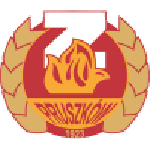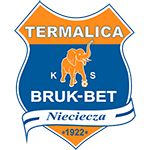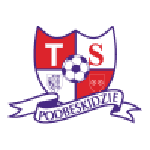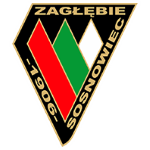| Coach | NA |
| Venue | Bogdanka Arena |
Górnik Łęczna predictions
Predictions for Górnik Łęczna: See upcoming and historic predictions for Górnik Łęczna below.
Disclaimer: Past performance does not guarantee future results. Betting involves risk; only wager what you can afford to lose. Always gamble responsibly.
Górnik Łęczna latest results
| 12/04 | - | ||
| 05/04 | - | ||
| 30/03 | 2 - 3 | ||
| 03/03 | 1 - 1 | ||
| 26/02 | 0 - 1 |
Górnik Łęczna latest transfers
| Date | Player | From | To | Price |
|---|---|---|---|---|
| 2022-07-26 | P. Banaszak | Górnik Łęczna | Pakhtakor | € 125K |
| 2015-09-01 | F. Černych | Górnik Łęczna | Jagiellonia | € 125K |
I Liga standings
| Rank | Team | MP | W | D | L | GF | GA | GD | Pts |
|---|---|---|---|---|---|---|---|---|---|
| 1 |
 Arka Gdynia
Arka Gdynia
|
26 | 15 | 6 | 5 | 43 | 25 | 18 | 51 |
| 2 |
 Lechia Gdansk
Lechia Gdansk
|
25 | 15 | 5 | 5 | 43 | 20 | 23 | 50 |
| 3 |
 Motor Lublin
Motor Lublin
|
26 | 13 | 5 | 8 | 36 | 31 | 5 | 44 |
| 4 |
 GKS Katowice
GKS Katowice
|
25 | 12 | 6 | 7 | 45 | 25 | 20 | 42 |
| 5 |
 Górnik Łęczna
Górnik Łęczna
|
26 | 10 | 12 | 4 | 29 | 24 | 5 | 42 |
| 6 |
 Tychy 71
Tychy 71
|
26 | 13 | 3 | 10 | 32 | 29 | 3 | 42 |
| 7 |
 Wisla Krakow
Wisla Krakow
|
26 | 11 | 8 | 7 | 48 | 32 | 16 | 41 |
| 8 |
 Wisla Plock
Wisla Plock
|
26 | 11 | 8 | 7 | 38 | 35 | 3 | 41 |
| 9 |
 Miedz Legnica
Miedz Legnica
|
26 | 9 | 10 | 7 | 35 | 28 | 7 | 37 |
| 10 |
 Odra Opole
Odra Opole
|
26 | 10 | 7 | 9 | 29 | 27 | 2 | 37 |
| 11 |
 Chrobry Głogów
Chrobry Głogów
|
26 | 9 | 5 | 12 | 29 | 41 | -12 | 32 |
| 12 |
 Znicz Pruszków
Znicz Pruszków
|
25 | 9 | 4 | 12 | 20 | 28 | -8 | 31 |
| 13 |
 Nieciecza
Nieciecza
|
26 | 7 | 9 | 10 | 39 | 39 | 0 | 30 |
| 14 |
 Stal Rzeszów
Stal Rzeszów
|
25 | 8 | 5 | 12 | 34 | 43 | -9 | 29 |
| 15 |
 Resovia Rzeszów
Resovia Rzeszów
|
25 | 7 | 4 | 14 | 28 | 46 | -18 | 25 |
| 16 |
 Polonia Warszawa
Polonia Warszawa
|
25 | 5 | 8 | 12 | 29 | 37 | -8 | 23 |
| 17 |
 Podbeskidzie
Podbeskidzie
|
26 | 4 | 9 | 13 | 20 | 41 | -21 | 21 |
| 18 |
 Zaglebie Sosnowiec
Zaglebie Sosnowiec
|
26 | 2 | 8 | 16 | 16 | 42 | -26 | 14 |
About Górnik Łęczna
Górnik Łęczna is a professional football club based in Łęczna, Poland. The club was established in 1979, and it has since become a significant part of the Polish football landscape. Górnik Łęczna's history is marked by its commitment to the sport, its community, and its enduring spirit of competition.
The club's name, Górnik, translates to "Miner" in English, a nod to the region's rich mining history. The team's colors, green and black, are also symbolic of the mining industry. The club's emblem, a miner's pickaxe and shovel, further emphasizes this connection. The team's identity is deeply rooted in the local community and its mining heritage.
Górnik Łęczna has spent most of its existence in the lower tiers of Polish football. However, the club has had its moments of glory. It has competed in the Ekstraklasa, the top tier of Polish football, on several occasions. Despite facing relegation, the team has always shown resilience and determination to bounce back to the top flight.
The club's home ground is the Łęczna Stadium, also known as the Górnik Stadium, which can accommodate over 7,000 spectators. The stadium is not just a football ground; it is a symbol of the town's passion for football. The fans, known for their unwavering support, create an electrifying atmosphere during matches, making the stadium a fortress for the team.
Over the years, Górnik Łęczna has nurtured many talented players who have gone on to represent Poland at various levels. The club's youth development program is known for its commitment to nurturing young talent and promoting them to the senior team.
Górnik Łęczna's journey has not been without challenges. The club has faced financial difficulties and has been on the brink of dissolution. However, the club's management, players, and supporters have always rallied together to ensure its survival. Their efforts have paid off, as the club continues to compete and maintain its status in Polish football.
In recent years, Górnik Łęczna has made significant strides in promoting women's football. The women's team, established in 2007, has been incredibly successful, winning multiple Polish Women's Championship titles and representing Poland in the UEFA Women's Champions League.
Górnik Łęczna's story is one of resilience, community spirit, and a deep love for football. Despite the challenges, the club continues to strive for success, driven by the passion of its players, staff, and loyal supporters. It remains a symbol of pride for the town of Łęczna and an integral part of Polish football.















